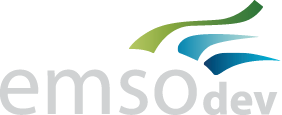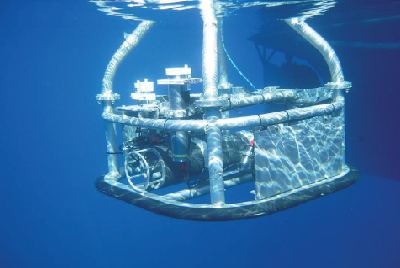Work packages
WP1 Lead beneficiary - ISTITUTO NAZIONALE DI GEOFISICA E VULCANOLOGIA
Work package title: Management
Start month 1 End month 36
Objectives
WP1 aims at leading EMSODEV to technical, organizational and financial achievement setting up the decision‐making structure and bodies. It also takes care of the management of the communication flow within the Consortium and with the European Commission, monitoring appropriateness of work, as well as prompt achievement of project deliverables.
WP1 handles the overall legal, contractual, financial and administrative issues.
Objectives to be achieved can be summarized as follows:
• Set up and run the decision-making structure and bodies;
• Lead the project to technical, organizational and financial achievement;
• Manage the communication flow within the Consortium and with the European Commission;
• Monitor appropriateness of work, as well as prompt achievement of project deliverables;
• Define quality criteria and ensure their application in the project activities and deliverables;
• Provide advice on legal and financial matters;
• Ensure that the overall project objective is met with high quality, on time and within budget;
• Distribute the EC contribution and monitor the concerned financial flow;
• Collect and submit project reports;
• Handle the Consortium Agreement.
WP2 Lead beneficiary HELLENIC CENTRE FOR MARINE RESEARCH
Work package title: Requirement definition and specification
Start month 1 End month 36
Objectives
The objective of the WP2 is to define the technical requirements of the generic instrument module, assemble all the sensor information and requirements to feed into WP3, WP4 and WP6. Following initial specification at the start of the project an iterative process will be continued throughout the project with feedback to update the specification and to provide an audit that final performance meets agreed criteria. WP 2 will act as custodian of the performance validation of the EMSO Generic Instrument Module (EGIM).
Following the leading idea of EMSODEV proposal, to design, develop and deploy a generic instrument module capable of measuring a specific set of variables at any EMSO site irrespective of depth and environmental conditions, this WP will provide the foundations on which the other WP’s will build upon. Today there is the possibility to measure and monitor a wide range of marine environmental variables with a varying degree of accuracy, often depending on the maturity of the sensing technology. Some of these variables are known as Essential Climate Variables, defined to support the work of the UN Framework Convention on Climate Change (UNFCCC) and the IPCC, while as sensor technology progresses rather fast, more variables are added.
Specific emphasis will be given on the implementation of innovative technologies, methodologies and approaches, as well as on quality control and harmonisation aspects. This WP will build on the existing knowledge from past and ongoing projects (ESONET, GEOSTAR, GEOSTAR2, ORION-GEOSTAR3, ASSEM, EMSO, FixO3, JERICO, NeXOS), as well as forums and international organisations.
Based on previous experience, practical sensors for physical, chemical and biological variables will be identified.
Continuous sampling frequency for each parameter and/or discontinuous event-driven sampling will be defined together with data rates and time-stamping needs. For cabled observatories, sensors, which can be activated in real-time from shore requiring duplex data flow, will be specially noted. A dependency matrix of sensors for calibration or event detection will be assembled.
For each sensor, calibration requirements, accuracy and precision with reference to global standards for oceanographic instruments or other relevant standards will be defined. The aim is a package of state of the art instruments that can operate unattended between expected service intervals, 6-12 months. The challenge will be a wide range of data rates from simple low data rate sensors such as pressure or temperature to sonar and optical imaging sensors with very high data rates. Required precision on data time stamping for different parameters will be evaluated. Power and interface requirements will be defined as well as the mechanical configuration requirements of each sensor, e.g. 3D orientation of the transducer with respect to the observatory structure.
WP3 Lead beneficiary: INSTITUT FRANCAIS DE RECHERCHE POUR L'EXPLOITATION DE LA MER
Work package title: EMSO Generic instrument Module (EGIM) Prototype
Start month 3 End month 14
Objectives
The objective of the WP3 is to develop the first Standardized EGIM that will be integrated and dry and wet tested. WP3 will benefit from work done in WP2 and results of this WP will feed WP4 and WP5. Detailed activities include:
• Design of a standard EGIM (EMSO Generic Instrument Module) able to be easily connected to any EMSO node type, either cabled or stand-alone, either pelagic or seafloor. The design will consider the generic sensors specified in WP2
• Development (i.e. design and implementation) of the basic driver software according to the devices/sensors manufacturer documents and the state of the art of experienced EMSODEV partners.
During the project lifecycle, the opportunity to add more than 6 basic sensors will be investigated. We will also consider the extendibility of the module during the design phase: front-end will be able to host further instruments for eventual implementation in WP5.
Test of EGIM against environmental conditions and various operational configurations will be performed.
WP4 Lead beneficiary - CSIC
Work package title: EGIM shallow water performance assessment and validation
Start month 1 End month 16
Objectives
The objective of this WP is to evaluate the quality, operability and stability of EGIM, by describing the sensors and using a standardised testing package to monitor sensor functionality. This will be done primarily at a shallow water test site available on a cabled Observatory, and afterwards it will be tested in stand-alone and cabled observatories.
Recommendations will be provided for smooth transition to the integration at the EMSO nodes activities (WP5). A report activity will also include the horizontal description of safety issues, i.e. the HSE (health safety and environmental) requirements and the HAZID (risk identification) assessment during integration/validation tasks.
WP5 Lead beneficiary - NERC
Work package title: EGIM Replication and in situ performance evaluation
Start month 3 End month 36
Objectives
The objective of WP5 is to deploy the various EMSO Generic instrument Modules (EGIMs) at several EMSO nodes to fully demonstrate their operational capability in situ. While several projects have outlined scientific requirements and design aspects of standardised ocean observing approaches for inter and multi-disciplinary research, several factors have limited the actual instillation of such systems at multiple EMSO sites. This WP will realize the long-term aspiration of standardise observation of scientific value across a range of sites around Europe, entailing such concepts as observing ‘essential ocean variables’.
The key challenge is to bring the modules from test scenarios to scenarios and settings that they will face in the longer-term operation of the EMSO infrastructure and evaluate their effectiveness. While bench, wet and shallow water testing can be beneficial, they can often miss key issues or failure modes that only appear under specific conditions (such as temperature, oxygen concentration, biofouling) or appear only after longer periods of time than are typically accommodated under testing. Following procurement based on the final specification through a tender, the module systems will be shipped from the test sites to the node host partners where they will be re-assembled and tested. Then, each of the variants (including water column and seafloor, as well as cabled and stand-alone variants) will then be deployed across a range of conditions. This range of conditions is made possible through the range of environments that span the EMSO nodes from the Arctic through the Atlantic to the Mediterranean, from surface to abyssal seafloor. The data, which will be reported back to shore via the EMSO observatory infrastructure in real time (or near real time), will then be evaluated for a period of months to review their ability to meet the scientific observation needs and requirements set out in WP2.
WP6 Lead beneficiary - ISTITUTO NAZIONALE DI GEOFISICA E VULCANOLOGIA
Work package title: Data Management platform and related services
Start month 1 End month 30
Objectives
The objective of this WP is to define, model and implement the EMSO data management platform following the ENVRI reference Model built on the architectural concepts outlined within the ESONET, FIXO3 and JERICO projects. The platform will ingest, consolidate, process and archive data coming from the EMSO generic instrument modules (EGIM), integrate the data management architectures of regional EMSO nodes and will make data available to the EMSO portal and to other international initiatives, as well.
WP7 Lead beneficiary - GEOECOMAR
Work package title Communication and Dissemination
Start month 1 End month 36
Objectives
Effective communication and dissemination of the steps to be taken by the new pan-European Research Infrastructure EMSO-ERIC is of uppermost importance in increasing the visibility towards the scientific community, the policy makers and business communities, as well as to the wider public. As a distributed research infrastructure dedicated to the observatories of the seafloor and the water column phenomena, EMSO is having a major role in supporting the European marine sciences and technology is to enter a new paradigm of knowledge in the XXI Century. Nevertheless, all these major steps forward in servicing the advancement of sciences, as well as scientific and innovation opportunities offered by the EMSO observatories, must be presented and clearly brought to the attention of the scientists, the public and interested stakeholders.
This is why the EMSODEV dissemination will be addressed in different but dedicated ways to the various categories of beneficiaries, resulting in focused actions. A special focus will include the different EMSO facilities products (observatories, data, etc.) and their potential: from addressing societal challenges to offering R&D opportunities, from promoting new business development to giving a step change in knowledge.
WP8 Lead beneficiary - MARINE INSTITUTE
Work package title Exploitation and Commercialisation
Start month 1 End month 36
Objectives
Blue Growth is the long term strategy of the European Union to support sustainable growth in the marine and maritime sectors as a whole which have great potential for innovation. This WP is EMSODEV’s contribution to achieving the goals of the Europe 2020 strategy for smart, sustainable and inclusive growth.
The key challenge of this WP is to identify and set up activities to increase the potential for innovation of EMSODEV technological output and thus contribute to increase the innovation potential of the EMSO observatories. While many of the deep sea observatory projects have typically focused on the science drivers behind ocean observation, it is increasingly important that commercial contributions to promising areas are fully developed. Therefore this WP will be focused on:
• assessing market applications and commercialisation opportunities for the generic instrumentation module and associated Software Package in areas like ocean energy, sea bed mining and marine knowledge are fully explored
• identifying and implementing products and services relating to the EGIM in niche sectors with a high potential to impact in areas of innovation relating to the EGIM
• enhancing existing networking with industries (including SME clusters across Europe) to facilitate their involvement as partners of the research infrastructures for technological developments.
• developing customised services for industry and SMEs and disseminate research outcomes and technology transfer with a particular focus on industry and SMEs



